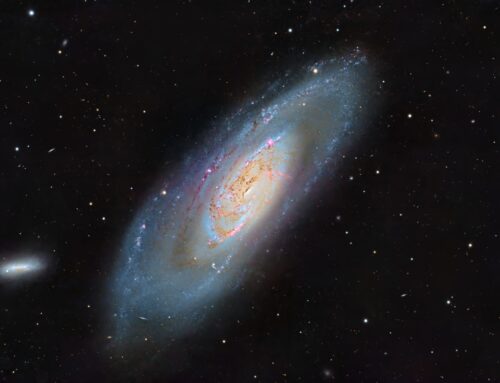M52 and The Bubble Nebula
Click image for full size version
December 28, 2014
I’ve imaged the Bubble Nebula up close. But when I looked at my star atlases, I saw that it is located in a very busy patch of sky. Many deep sky objects show up nicely in this image captured in November 2012:
- The Bubble Nebula (NGC7635) is the most famous object in this image, at top centre. The bubble is surrounded by Sh2-162, a billowy, textured cloud of glowing hydrogen gas. Both are between 7000-11,000 light years away.
- The open cluster M52 sparkles right of centre, and is located 5,000 light years away. It is one of my favourite small telescope open clusters.
- At left centre, is nebula NGC7538, 9,100 light years away. NGC7538 contains the largest known protostar, of more than 300 solar masses.
- The large, faint, Sh2-161 is at lower left, also around 9100 light years from us.
- The small isolated patch of nebulosity left of the Bubble Nebula may be part of Sh2-171; I couldn’t be sure of this.
- Cz43 (Czernik 43) is an inconspicuous open cluster that I probably wouldn’t have noticed had it not been referenced in one of my star atlases. You can find it halfway from M52 to the brightest star to its upper right.
Tekkies:
SBIG STL-11000M camera, Baader LRGB filters, 10″ f/3.6 ASA astrograph, MI-250 mount. Focusing with FocusMax. Guided with STL-11000’s internal guider. Acquistion, guiding, calibration, registration and integration all done using Maxim-DL. All other processing in PixInsight. Shot from my SkyShed in Guelph, Ontario. No moon for RGB; gibbous moon for Ha. Very poor transparency and average seeing for all three sessions, with fog and cloud.
6x10m of R, G, B and 7x20m Ha (total 5hr20m).
HaRGB:
Ha, R, G and B masters were cropped to remove edge artifacts from stacking. The R, G and B channels were combined to make an RGB image. Ha and RGB were processed with DBE, combined with the NB-RGB script, and Colour Calibration was applied. HistogramTransformation was applied, followed by TGVDenoise and another HistogramTransformation to reset the black point.
Synthetic Luminance:
Creation and cleanup: The R,G,B and Ha masters were combined using the ImageIntegration tool (average, additive with scaling, noise evaluation, iterative K-sigma / biweight midvariance, no pixel rejection). DBE was applied to neutralize the background.
Deconvolution: A star mask was made to use as a local deringing support. A copy of the image was stretched to use as a range mask. Deconvolution was applied (100 iterations, regularized Richardson-Lucy, external PSF made using DynamicPSF tool with about 40 stars).
Stretching: HistogramTransformation was applied, followed by TGV Denoise and another HistogramTransformation to reset the black point. No pixels were clipped during either stretch. The Curves tool was used to boost brightness, contrast and saturation of the nebula.
Combining SynthL with HaRGB:
The luminance channel was extracted, processed and then added back into the HaRGB image as follows:
1. Extract luminance from the HaRGB image.
2. Apply LinearFit using the SynthL channel as a reference.
3. Use ChannelCombination in the Lab mode to replace the luminance of the HaRGB with the fitted luminance from step 2.
4. LRGBCombine was then used to make a SynthLHaRGB image.
Final Processing:
Small-scale structures were isolated using MultiscaleLinearTransform (4 wavelet layers, residual layer deselected) on a copy of the SynthLHaRGB image. Large-scale structures were isolated by subtracting the small-scale image from the SynthLHaRGB (no rescaling). A duplicate of the small-scale image was used as a mask on the small-scale image and contrast was boosted. Colour saturation and contrast were boosted on the large-scale image. Then small-scale and large-scale images were added back together in PixelMath. ExponentialTransformation was applied to a masked version of the image, protecting the stars and bright parts of the nebula. Colour saturation and curves were adjusted slightly.
Image scale is about 2.2 arcsec per pixel for this camera / telescope combination.







Leave A Comment